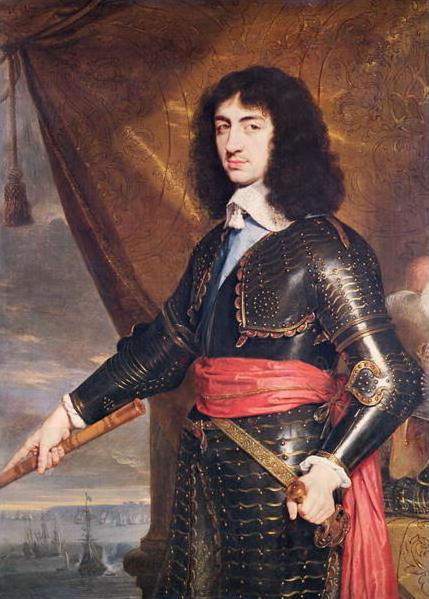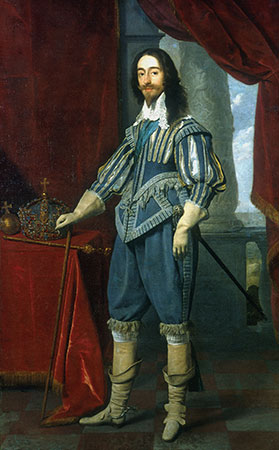 Certainly a sympathetic character early in his life, this week’s monarch of Royal Branding, England’s Charles II, does much through his actions to wreck the glowing personal brand with which he ascends to the throne, but by the same personal brand he later resurrects himself.
Certainly a sympathetic character early in his life, this week’s monarch of Royal Branding, England’s Charles II, does much through his actions to wreck the glowing personal brand with which he ascends to the throne, but by the same personal brand he later resurrects himself.
Charles was only a teenager when he learned that his father, King Charles I, was literally losing his battle against Parliament’s New Model Army for control of the government. In 1646, young Charles the heir was sent away for safety, and lived in exile with his mother in France. After his father was executed by Parliament in 1649, a devastated young Charles had to depend on the generosity of Royalist friends and relatives throughout the Interregnum, when Oliver Cromwell was Lord Protector of England’s Commonwealth.
In spite of great expectations, Cromwell’s government and his strict Puritan policies were not popular. In the mid-1650s, even Christmas was banned. When Cromwell died in 1658, his son and heir Richard drew little confidence. The leaders of Parliament “had come to the painful realization that, by attacking what they saw as the excesses of the rule of the new King’s father, they had actually undermined their own power and then been obliged to look on as people they saw as fanatics experimented with the ever more distasteful rigours of godly rule. The Royalist gentry were now determined to reassert their traditional rights, and a traditional monarchy seemed the best means to guarantee these.”

Young Charles, now 30, was at last invited to return to England for coronation—as long as he promised not to punish those who had fought against his father.
Here was an unprecedented opportunity to capitalize on England’s love for its monarchy, to demonstrate to all the world the grandeur and prestige of king and kingdom, to restore faith in royal government and be loved throughout the country for restoring the traditional merry English lifestyles that had long been prohibited. Charles could define himself clearly in the eyes of his people and distinguish himself as a light leading forward, away from the troubled past.
His coronation was designed for exactly that, with “dazzling pageantry” for which no expense was spared:
- Fountains ran with wine, soldiers wore red, white and black plumes
- The horse of state had a saddle worked with gold and pearls, the stirrups decorated with 12,000 jewels.
- The king’s robes were cloth of gold, red velvet and crimson satin. He wore golden high-heeled shoes to stand above the others. Images, poems, architecture, and sermons celebrated Charles’ heroic return.
- He was the new Solomon. The Golden Age had returned.
But a brand of such high aspirations required significant care and maintenance.
Royal Brand Values
Strong personal brands are based on values. Charles II valued many things, including art, architecture, ships and science, but above all he had “an absolute commitment to his own survival.”
He wanted to reestablish the monarchy as an effective political power, and assigned Edward Hyde, his trusted Lord Chancellor, to manage it for him.
 He wanted to be respected as a wise and sober man. While most of his courtiers dressed in brilliant pastels, Charles chose somber shades of brown and dark blue, and chose his signature fashion of long, fitted and embroidered coats “that emphasized his height and, in a strange way, his self-contained isolation.”
He wanted to be respected as a wise and sober man. While most of his courtiers dressed in brilliant pastels, Charles chose somber shades of brown and dark blue, and chose his signature fashion of long, fitted and embroidered coats “that emphasized his height and, in a strange way, his self-contained isolation.”
Charles wanted to restore what his father had died fighting for: the Divine Right of kings to summon and dismiss parliaments, to create peers, bishops and judges, to declare war and make peace, and to “embody in himself the majesty of state.” To this end he was wary and mindful, acted “with caution and charm,” but also tended toward duplicity, to pursue two different and conflicting policies.
Charles, whose exile years had involved much idleness, resentfulness, drinking and physical pleasures, perhaps lacked the drive to support these values. Observers considered Charles capable of hard work and concentration, but “would increasingly show himself as easily distracted and indolent.” The French King Louis XIV considered him lazy.

Nell Gwyn
Inevitably, conflicts with Parliament arose over religious unity and tolerance, who could hold public office, who could decide about the sale of public property, who could declare a trade war with the Dutch, and more. While leaving most of the business of government to his councilors, Charles descended into debauchery and sexual excess. He is known for his many mistresses, such as Lady Castlemaine and the actress Nell Gwyn. In 1661 Samuel Pepys wrote in his diary, “at court things are in very ill condition, there being so much emulation, poverty and the vices of swearing, drinking and whoring, that I do not know what will be the end of it but confusion.”
Times were disastrous. There was war, famine, an outbreak of bubonic plaque that killed 30,000, and the great fire of 1666 that consumed more than 13,000 London houses. Rumors circulated that the sins of court had brought such retribution. Making matters worse, Charles’s wife was unable to produce an heir, and Charles’s brother James, the next in line to the throne, was Catholic. Catholicism had been widely feared and hated in England since the time of Henry VIII.
When a false threat of a Catholic assassination plot stirred both government and citizens to hysteria, a savvy Parliamentarian, the Earl of Shaftsbury, used all of these elements to his advantage to manipulate and take control of the government, and even to change the king’s own plan of succession. He pushed Charles to the brink his father had known, threatening to destroy forever the Divine Right in which Charles so strongly believed and had vowed to protect.
Brand Undermines Crisis
But, as so many good stories end, when things reached crisis point the protagonist remembered his core values and strengths, and successfully brought them to bear.
Charles II summoned the last Parliament of his reign. At the entrance to the hall his Sergeant of Arms called for silence, and members found their monarch seated on his throne, wearing the voluminous robes of state, the crown of England shining on his head.
“A wave of awe fell across the room. Charles was no longer the shifty, manipulative and fallible man the Whigs believed they had in their grasp. He was arrayed in the sumptuous pageantry of a quasi-divine power. He was the Lord’s anointed, vested with a holy authority and incorruptible. Where the dismayed Whigs drew their arguments from reason he drew his power from God, and it was with this assurance…that Charles now spoke…”
~ Stephen Coote, Royal Survivor
Charles gave a speech that recalled the king he had intended to be, his words “subtle and crafty,” his tone firm but reasonable. “He would uphold traditional constitutional decencies in the face of what appeared to many to be the Whig desire for absolute power.”
In a time of crisis, King Charles returned to the basics of his brand established at his coronation, and in the process he was giving his audience just what they wanted and needed: a powerful leader divinely guided. At the last, the elements of Charles’s personal brand and its symbols of power saved him.
Gems from the Crown
Charles II’s story is long, varied and complex, but there are important lessons to be learned for any personal brand:
- Once you define your true brand values, treasure them, support them and exemplify them consistently. They engender respect.
- In times of crisis, use those values and the symbols of them. Once imbued with the meaning of your brand, the symbols themselves project the values in your presence or in your absence. They carry and support the unseen power of your brand.
Thanks to: Stephen Coote, Royal Survivor; Christopher Hill, The Century of Revolution 1603-1714; Wikipedia Creative Commons, images in public domain.
Create your own royal brand:
 Brand Yourself Royally in 8 Simple Steps gives you lessons learned from some of the strongest royal brands, and walks you through the process to create your own unforgettable brand, including vision and mission statements, persona and positioning, colors and tagline, and much more, plus communications planning to put your new brand into action. Available in soft cover and ebook.
Brand Yourself Royally in 8 Simple Steps gives you lessons learned from some of the strongest royal brands, and walks you through the process to create your own unforgettable brand, including vision and mission statements, persona and positioning, colors and tagline, and much more, plus communications planning to put your new brand into action. Available in soft cover and ebook.
For all my books and events, visit my website, www.nancyblanton.com





 Shared values provide the basis for a strong personal brand. In Charles’s case, his values centered around one core belief: that the king ruled by divine right—meaning that he was royal by blood, and had come to the throne by God’s will. His motto, “Dieu et mon droit” – God and My Right – came down from Henry V and Henry VII. Therefore, it was his right to rule by his own conscience and his direct contact to God. He did not need Parliament to tell him what to do. This belief was his strength, and ultimately his downfall.
Shared values provide the basis for a strong personal brand. In Charles’s case, his values centered around one core belief: that the king ruled by divine right—meaning that he was royal by blood, and had come to the throne by God’s will. His motto, “Dieu et mon droit” – God and My Right – came down from Henry V and Henry VII. Therefore, it was his right to rule by his own conscience and his direct contact to God. He did not need Parliament to tell him what to do. This belief was his strength, and ultimately his downfall.
 Nancy Blanton is the award-winning author of historical novels and the personal branding book,
Nancy Blanton is the award-winning author of historical novels and the personal branding book,